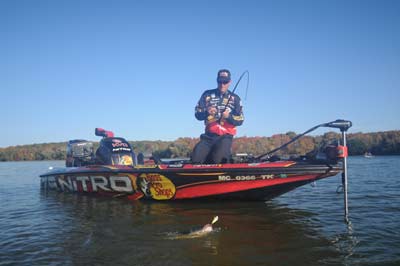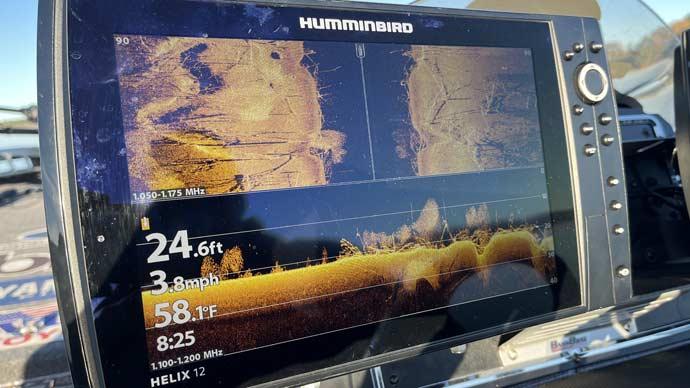
My trusty Minn Kota Maxxum trolling motor has served me well for the last 15 years.
I knew it was time for a replacement though when the trolling motor started making a grinding noise all the time and it was getting harder to turn the motor with the foot control. The allure of new trolling motor technology such as GPS anchoring and other features prompted me to start shopping around for a replacement for my Ranger 188 bass boat.
Today’s trolling motors come with a variety of features which gave me a lot of options to match the right motor with my boat’s size and my style of fishing. Probably the most important factor in selecting a trolling motor is how much thrust the motor delivers. The motor’s thrust is determined by an engineering formula used by all trolling motor manufacturers. A trolling motor technician once told me thrust is measured by hooking a trolling motor to a machine that measures in units of pounds for how much push the motor has in the water and how many amps the motor uses before it stalls. My Maxxum trolling motor had 70 pounds of thrust so I was looking for a replacement in the 70- to 80-pound range to move my 18-foot, 8-inch bass boat.
Shaft length was the next key element I had to consider when choosing a new trolling motor. Measuring the top of the boat’s bow to the water level with a full load in your boat will determine the right shaft length for your trolling motor. Add 15 inches to your measurement to make sure the lower unit of the trolling motor will be positioned at the proper depth and add another 3 inches for up-and-down adjustments. A 42- to 50-inch shaft length is recommended for most bass boats depending on the body of water you frequently fish. Longer shaft lengths are recommended for large bodies of water where larger waves are common.
Trolling motor voltage was also a key consideration in my selection process. My previous trolling motor ran on two 12-volt batteries so I wanted to stick with a 24-volt trolling motor rather than having to add another battery for a 36-volt motor.
Here is a look at the five options I had available to replace my old trolling motor.
Minn Kota Ultrex
As a longtime Minn Kota user, I selected the 24-volt, 80-pound thrust Ultrex trolling motor with a 45-inch shaft to replace my old Maxxum. The Ultrex turns smoothly with its power steering and wireless foot pedal and the GPS boat control Spot-Lock button is great for keeping my boat in one spot while I have to change lures or stay on a windy point. The motor also has a Bluetooth micro remote which I haven’t taken advantage of yet.
Another handy feature is the Lift-Assist that makes it easier to stow and deploy the motor. A Humminbird Dual Spectrum CHIRP sonar transducer is built into the lower unit, but I elected to attach an external transducer because I use Garmin electronics on the bow of my boat. The Ultrex I purchased from the Minn Kota web site has a manufacturer’s suggested retail price of $2,999.
Garmin Force
The trolling motor that best suited my boat is equipped with a 50-inch shaft and 80 pounds of thrust at 24 volts. It also has electric steering and a Lift-Assist with dual gas springs.
The Force has a built-in GPS with autopilot features on Anchor Lock, following routes, holding a heading and cruise control. The motor’s built-in transducer with CHIRP sonar and ClearVu and SideVu imaging would have matched up perfectly with my Garmin Echomap unit.
Another great feature is the motor’s handheld remote control that is water-resistant and floats in case it accidentally goes overboard. Programmable keys can also be used to control a Garmin chart plotter. This Force model sells for $3,549.99 on the Garmin web site.
Lowrance Ghost
The best choice for my Ranger was the 24-volt Lowrance Ghost with a powerful 97 pounds of thrust and a 47-inch shaft.
The Ghost’s autopilot features include custom routes, anchor and heading locks, constant on and turn patterns. The motor also has a dual-action gas spring for easier stowing and deploying. The Ghost auto feature allows the motor to align itself to lay flat and secure on the mount when stowing. Lowrance claims the Ghost’s brushless motor runs quietly and emits zero electromagnetic interference to ensure clear sonar views on your fish finder.
The motor features an Hdi Sonar Nosecone transducer that supports medium and high chirp sonar and DownScan Imaging. The Ghost 47-inch model’s listed price on the Lowrance website is $3,499.
MotorGuide Tour Pro
This longtime trolling motor manufacturer has a 24-volt Tour Pro model with 82 pounds of thrust and a 45-inch shaft that would have matched up with my boat.
Priced at $2,899.99 on the MotorGuide website, the Tour Pro features Pinpoint GPS anchoring to stay on your fishing spots along with heading lock and constant on buttons. Instant response cable steering creates quick and smooth turning of the motor.
The Tour Pro offers HD+ universal sonar capability that matches whatever sonar unit you use. A Zero-G lift assist system makes for a quiet and effortless stowing and deploying of the motor. Another great feature is an LED dashboard that indicates power, battery and GPS status.
Power Pole MOVE
New to the trolling motor game, Power Pole has introduced the brushless MOVE motor with two editions, the MOVE ZR scissors-lift and the MOVE PR pivot mount. THE MOVE ZR model has the traditional scissors mount with the pull chord for deployment and stowing whereas the MOVE PR pivot mount has a quick release foot pedal for the same chores.
Both models have 24 volt setups and 45-inch shafts with 78 pounds of thrust. The trolling motors include a lifetime warranty on the titanium shaft and three-year warranty on the mechanics.
The Move is equipped with advanced GPS navigation features such as Anchor Mode, Vector Mode for heading your boat in a straight line, route following and compass heading to travel to a selected compass point. The brushless motor is built with a Power Unity System which allows the MOVE to deliver more power at lower RPMs resulting in greater thrust and efficiency and silent operation.
Dealer pricing for both the MOVE PV and MOVE ZR is $4,999.99.




